Top Rankings
River Mill Academy School District ranks among the top 20% of public school district in North Carolina for:
Category
Attribute
Overall Rank
Highest overall rank (Top 20%)
Math Proficiency
Highest math proficiency (Top 20%)
Reading/Language Arts Proficiency
Highest reading/language arts proficiency (Top 20%)
For the 2025 school year, there is 1 public school serving 768 students in River Mill Academy School District. This district's average testing ranking is 9/10, which is in the top 20% of public schools in North Carolina.
Public School in River Mill Academy School District have an average math proficiency score of 73% (versus the North Carolina public school average of 51%), and reading proficiency score of 67% (versus the 50% statewide average).
Minority enrollment is 35% of the student body (majority Hispanic and Black), which is less than the North Carolina public school average of 57% (majority Black and Hispanic).
Overview
This School District
This State (NC)
# Schools
1 School
2,764 Schools
# Students
768 Students
1,547,014 Students
# Teachers
46 Teachers
100,085 Teachers
Student : Teacher Ratio
17:1
17:1
District Rank
River Mill Academy School District, which is ranked within the top 20% of all 320 school districts in North Carolina (based off of combined math and reading proficiency testing data) for the 2021-2022 school year.
The school district's graduation rate of 90% has stayed relatively flat over five school years.
Overall District Rank
#41 out of 325 school districts
(Top 20%)
(Top 20%)
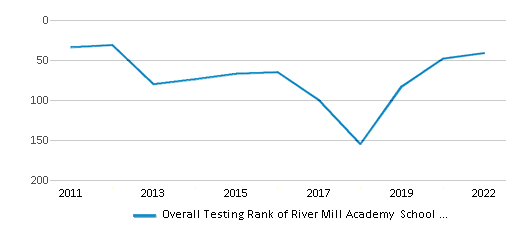
Math Test Scores (% Proficient)
73%
51%
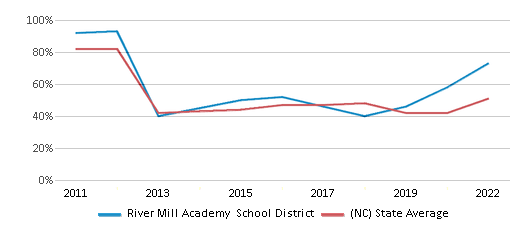
Reading/Language Arts Test Scores (% Proficient)
67%
50%
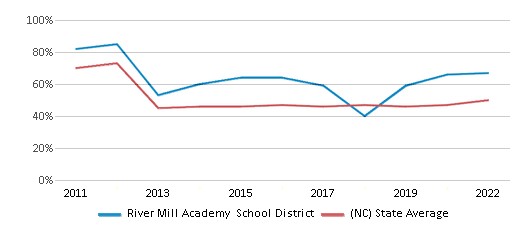
Science Test Scores (% Proficient)
70-74%
63%
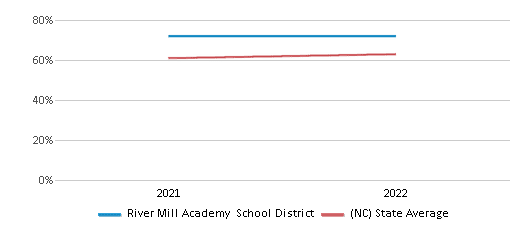
Graduation Rate
≥90%
86%

Students by Ethnicity:
Diversity Score
0.54
0.71
# American Indian Students
1 Student
16,971 Students
% American Indian Students
n/a
1%
# Asian Students
10 Students
65,132 Students
% Asian Students
1%
4%
# Hispanic Students
110 Students
326,941 Students
% Hispanic Students
15%
21%
# Black Students
106 Students
380,120 Students
% Black Students
14%
25%
# White Students
501 Students
665,292 Students
% White Students
65%
43%
# Hawaiian Students
n/a
2,147 Students
% Hawaiian Students
n/a
n/a
# Two or more races Students
40 Students
92,182 Students
% of Two or more races Students
5%
6%
Students by Grade:
# Students in PK Grade:
-
23,648
# Students in K Grade:
71
110,403
# Students in 1st Grade:
67
114,331
# Students in 2nd Grade:
71
118,121
# Students in 3rd Grade:
70
111,941
# Students in 4th Grade:
69
114,493
# Students in 5th Grade:
68
115,565
# Students in 6th Grade:
65
116,023
# Students in 7th Grade:
56
116,793
# Students in 8th Grade:
58
119,029
# Students in 9th Grade:
45
137,977
# Students in 10th Grade:
45
126,349
# Students in 11th Grade:
48
117,582
# Students in 12th Grade:
35
104,759
# Ungraded Students:
-
-
District Revenue and Spending
The revenue/student of $9,301 in this school district is less than the state median of $11,187. The school district revenue/student has grown by 8% over four school years.
The school district's spending/student of $8,236 is less than the state median of $11,612. The school district spending/student has grown by 8% over four school years.
Total Revenue
$7 MM
$17,307 MM
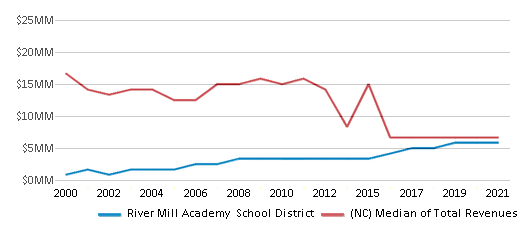
Spending
$6 MM
$17,964 MM

Revenue / Student
$9,301
$11,187
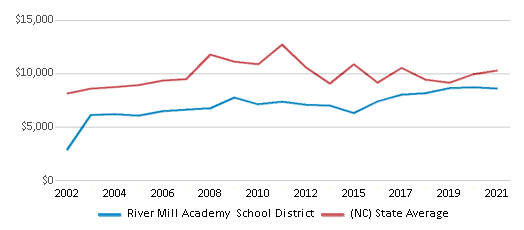
Spending / Student
$8,236
$11,612
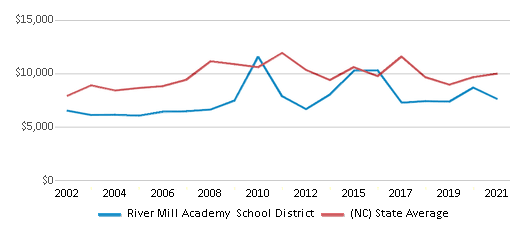
Best River Mill Academy School District Public Schools (2025)
School
(Math and Reading Proficiency)
(Math and Reading Proficiency)
Location
Grades
Students
Rank: #11.
River Mill Academy
Charter School
(Math: 73% | Reading: 67%)
Rank:
Rank:
9/
Top 20%10
235 Cheeks Lane
Graham, NC 27253
(336) 229-0909
Graham, NC 27253
(336) 229-0909
Grades: K-12
| 768 students
Frequently Asked Questions
How many schools belong to River Mill Academy School District?
River Mill Academy School District manages 1 public schools serving 768 students.
What is the rank of River Mill Academy School District?
River Mill Academy School District is ranked #41 out of 320 school districts in North Carolina (top 20%) based off of combined math and reading proficiency testing data for the 2021-2022 school year. This district ranks in the top 20% of North Carolina school districts for: Highest overall rank (Top 20%), Highest math proficiency (Top 20%) and Highest reading/language arts proficiency (Top 20%)
What is the racial composition of students in River Mill Academy School District?
65% of River Mill Academy School District students are White, 15% of students are Hispanic, 14% of students are Black, 5% of students are Two or more races, and 1% of students are Asian.
What is the student/teacher ratio of River Mill Academy School District?
River Mill Academy School District has a student/teacher ratio of 17:1, which is higher than the North Carolina state average of 15:1.
What is River Mill Academy School District's spending/student ratio?
The school district's spending/student of $8,236 is less than the state median of $11,612. The school district spending/student has grown by 8% over four school years.
Recent Articles

Year-Round Or Traditional Schedule?
Which is more appropriate for your child? A year-round attendance schedule or traditional schedule? We look at the pros and cons.

Why You Should Encourage Your Child to Join a Sports Team
Participating in team sports has a great many benefits for children, there is no doubt. In this article you will learn what those benefits are.

White Students are Now the Minority in U.S. Public Schools
Increasing birth rates among immigrant families from Asia and Central and South America, combined with lower birth rates among white families, means that for the first time in history, public school students in the United States are majority-minority. This shift in demographics poses difficulties for schools as they work to accommodate children of varying language abilities and socio-economic backgrounds.





